
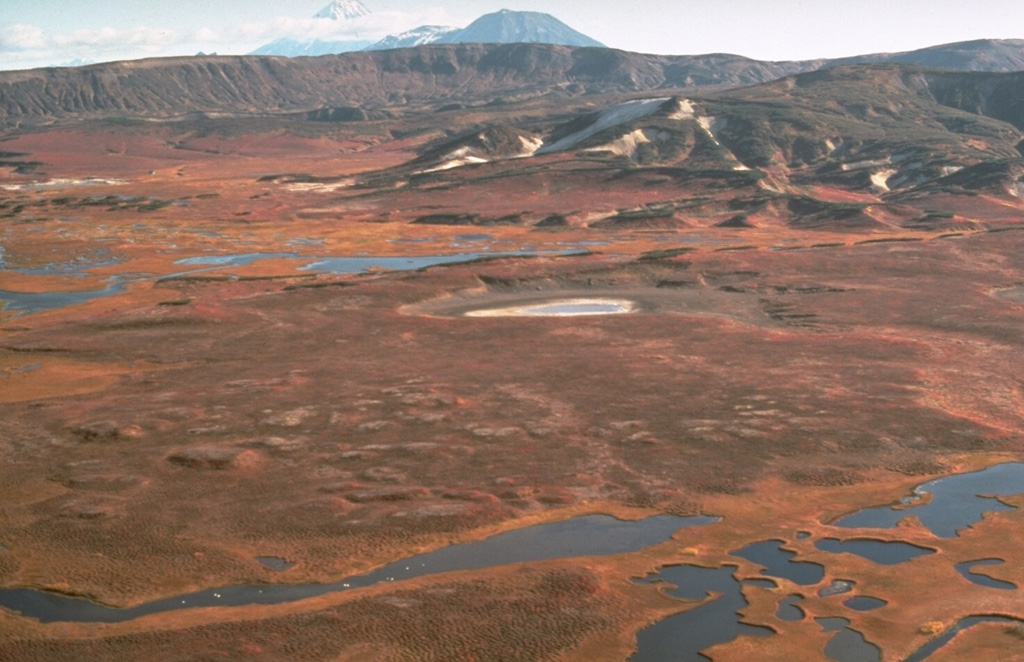
Valley of Geysers two years after the major landslide of June 2007
Our previous report on the Valley of Geysers (BGVN 32:07) discussed a major landslide on 3 June 2007 that seriously damaged the landscape and destroyed several beautiful geysers. Scientists again visited the area about two years after the landslide. One of the geysers that was a few meters underwater returned to life after the confining lake waters dropped below the geyser's rim.
The following report came chiefly from Vladimir L. Leonov and his son, A.V. Leonov, who wrote an informal description of events (Leonov, 2008). The S-trending Valley of Geysers cuts radially across the topographic margin of the Geysernaya caldera at the SE end of the Uzon-Geysernaya caldera complex (figure 9).
As previously reported, the landslide created a dam on the Geysernaya River, forming a lake. According to Leonov (2008), the lake surface rose to a maximum elevation of 435 m on 7 June 2007, before eroding, causing a rapid decline in water level to 426 m elevation.
During July and August 2007, the Emergency and Disaster Relief Ministry and volunteers deepened the new bed of the Geysernaya River by hand to lower the lake level by another 2 m, thus freeing the Bolshoi geyser vent from the cover of lake water. After these efforts, on 19 September 2007, the Bolshoi geyser revived and erupted for the first time since the 2007 landslide.
When studied in October 2008, the Bolshoi geyser (figure 10) responded to minor fluctuations of the water level in the lake. Bolshoi was seen to operate in either the regime of a geyser or in the regime of a pulsating source. When the water was low, the geyser regime was seen. With the rise of water of only about 10-15 cm (as a result rains or the melting of snow ) the water began to pour out of Bolshoi's vent in episodic pulsations.
The thickest section of landslide completely covered the 30-m waterfall at Vodopadny Creek (a branch of the Geysernaya River), and the geysers Troynoi (Triple), Sakharny (Sugary), and Sosed (Neighbor) (figures 11 and 12).
Reference. Leonov, A.V., 2008, Valley of Geysers 500 days later; (URL: http://spanishflyer.livejournal.com/39861.html); accessed on 6 July 2009.
Information Contacts: Vladimir L. Leonov, Institute of Volcanology and Seismology FED RAS, Far East Division, Russian Academy of Sciences, Piip Ave. 9, Petropavlovsk-Kamchatsky 683006, Russia (URL: http://www.kscnet.ru/ivs/kvert/); Milkovo (URL: http://www.milkovo.ru/); Dmitry Zadirey, Air Company Kamchatka Airlines, Yelizovo, Russia.
The Global Volcanism Program has no Weekly Reports available for Uzon.
Reports are organized chronologically and indexed below by Month/Year (Publication Volume:Number), and include a one-line summary. Click on the index link or scroll down to read the reports.
Valley of Geysers struck by large destructive landslide and related flood
On 3 June 2007 the renowned Valley of Geysers in Kamchatka was seriously damaged by direct burial and subsequent flooding associated with a major landslide. This was communicated in a report from 28 June by the father-and-son team of Vladimir and Andrei Leonov. The Valley of Geysers is a remote geothermal area along a 4-km-long valley near the E margin of Geyzernaya caldera at Uzon-Geyzernaya volcano-tectonic depression ("U"; Leonov and others, 1991) (figure 1).
Although the name Uzon is entrenched in the literature, the shorthand is potentially confusing since it could refer to the caldera on the W side of the complex. Both Uzon and Geyzernaya calderas support hydrothermal systems feeding thermal features. Moreover, a small cone named Uzon resides on the W rim of Uzon caldera. Accordingly, in this report we will refer to the larger complex as Uzon-Geyzernaya. The landslide which entered the Valley of Geysers is refered to as the 2007 Geyzernaya landslide.
The area where the slide occurred was the subject of a recent paper (discussed below) on satellite-detected uplift on the same E side of the caldera where the slide took place (Lundgren and Lu, 2006). "Ic" indicates the approximate center of inflation detected by satellite radar interferometry using data from 2000 to 2003 (Lundgren and Lu, 2006 ).
According to the Leonovs' report, several beautiful geysers have been lost, including Pervenets, the first geyser discovered by Tatyana Ustinova in 1941, and a group of geysers known as Troynoy group. The main geyser field, Vitrazh, and the largest geyser, Velikan, remained intact (table 1 and figure 2).
Table 1. Summary and key to names and numbers for Valley of Geysers, about half of which were disrupted or destroyed by the 2007 Geyzernaya landslide. The numbers correspond with those on figures 2 and 3. Courtesy of Vladimir and Andrei Leonov.
| Number | Status | Name | English translation of name |
| 1 | Covered by slide | Pervenets | First born |
| 2 | Covered by slide | Troynoi | Triple |
| 3 | Covered by slide | Sakharny | Sugar |
| 4 | Covered by slide | Sosed | Neighbor |
| 5 | Covered by slide | Uvodopada | Near the waterfall |
| 6 | Flooded by lake | Skalisty | Rocky |
| 7 | Flooded by lake | Konus | Cone |
| 8 | Flooded by lake | Bolshaya Pechka | Gross Owen |
| 9 | Flooded by lake | Maly | Lesser |
| 10 | Flooded by lake | Bolshoi | Greater |
| 11 | Active mid-Sep | Shchel | Crack |
| 12-16 | Active on 28 Jun | "Vitrazh" geyser field: Grot, Novy Fontan, Fontan, Dvoynoi, Nepostoyanny | "Stained glass" geyser field: Grotto, New Fountain, Fountain, Double, Unstable |
| 17 | Active on 28 Jun | Velikan | Giant |
| 18 | Active on 28 Jun | Zhemchuzhny | Pearl |
The landslide formed in the upper reaches of Vodopadny creek. The authors suggested that the main cause of the slide appeared to be the common process of gradual erosion. The nearest seismic instrument was ~ 100 km away; on that instrument at the time of the slide's onset, earthquakes were absent.
Correspondence with Vladimir Leonov on 11 September revealed that the slide's computed volume was then considered to be 12-15 million cubic meters. The report also stated that this was clearly the largest historical slide in Kamchatka and possibly one of the largest in all of Russia. Later correspondence clarified this comparison as excluding debris-avalanche deposits such as those associated with lateral blasts closely associated with eruptions in 1980 at St. Helens and in 1956 at Bezymianny.
The landslide of rock and mud went down the Vodopadny creek, reached the Geyzernaya river, and moved along the river to its inflow into the Shumnaya river (figures 2-4). The slide was ~ 2 km in length. A dam was formed on the Geyzernaya river with a height of up to 60 m that caused a rapid backup of water and the formation of a lake. The lake flooded the geysers Bolshoi and Maly located up the river and came close to the main "Vitrazh" geyser field. On 7 June the water level in the lake reached its maximum elevation of 435 m. Later that day the river eroded through the dam and the water level started to decline quickly. During the first four hours the water level subsided to 9 m depth. As of 28 June the main group of geysers appeared safe from flooding.
 |
Figure 3. Sketch map on 10 June 2007 showing features after the Geyzernaya landslide. N is to the upper right. The numbers correspond to those on table 1. Courtesy of Vladimir and Andrei Leonov. |
In the flooding of the Bolshoi and Maly geysers, Bolshoi ended up 2 m under water, and Maly, 15 m under water. In addition, several smaller geysers?Skalisty (Rocky), Konus (Cone), Bolshaya Pechka (Gross Owen)?were also flooded. The pulsating spring Malakhitovy Grot (Malachite Grotto) was half-flooded and sometimes boiled.
On 7 June a new geyser appeared in the Valley but it was active for only several hours. While the water level in the lake increased, a pulsating spring in front of Shchel geyser (perhaps The Little Prince) started to work as a geyser with eruption heights of 4-5 m. After the water level dropped, the geyser returned to a pulsating spring state.
One of the landslide's tongues came close to tourist-camp buildings in the Geyser Valley (figures 2-6). Although some camp facilities were destroyed, three main houses (a hostel, a scientist's house, and a ranger's house) were undamaged. As seen in figures 5 and 6, the edge of the slide reached within about a meter of the hostel and covered parts of the adjacent wood-decked walkway. People occupied buildings when the landslide occurred but the slide halted at a point where no one was injured.
 |
Figure 6. Landslide rubble came to rest near the hostel's side wall. From the Leonov's report; copyrighted photo by I.F. Delemen (IVaS FED RAS). |
At the time of the slide, a tourist group consisting of over 20 people were in the Valley, but fortunately they were at the thermal field near the river, and only helicopter pilots and some personnel remained at the camp. In addition to stopping near the buildings, the body of the lanslide stopped 1 m before the resting helicopter, but trees carried by the slide jutted out and entangled the helicopter.
The 30-m waterfall at the Vodopadny creek junction with Geyzernaya river was fully covered as well as the geyser near the waterfall. The "Thirty-meter rocks" at the entrance to the Geyser Valley were also covered by the landslide. All the small geysers, springs and thermal fields along Vodopadny creek were lost; however, the creek itself established a new course on the slide's surface.
Overall assessment. Eight large geysers were still functioning at the time of the report, about half of the main geysers that existed before the landslide (table 1). Five of these still working geysers were in the Vitrazh field (Grot, Fontan, Novy Fontan, Dvoynoi, and Nepostoyanny). The three others also still working were Velikan, Zhemchuzhny, and Shchel (the latter, initially submerged but by mid-September was 8 m above the lake level and seemingly returned to normal behavior.
Four large geysers were flooded by the lake (Bolshoi, Maly, Skalisty, Konus). Four were destroyed by the slide (Pervenets, Troynoi, Sakharny, and Sosed).
The Geyzernaya river found a new course on the landslide's surface. Caves developed on the slide's surface hosted small lakes. In several places on the river banks observers saw the emergence of earth slumps and new boiling springs (figure 7).
Other information. Igor Shpilenok, a nature photographer, has posted on the web a suite of impressive before-and-after photos. The photos include shots of the upland area that spawned the landslide prior to the event.
On 20 June, Jesse Allen from NASA published an article about the slide discussing a satellite image of the area captured on 11 June. He noted "The Advanced Spaceborne Thermal Emission and Reflection Radiometer (ASTER) on NASA's Terra satellite captured this infrared-enhanced image on [11 June] 2007, a week after the slide. The image shows the valley, the landslide, and the new thermal lake. Even in mid-June, just days from the start of summer, the landscape is generally covered in snow, though the geologically heated valley is relatively snow free. The tree-covered hills are red (the color of vegetation in this false-color treatment), providing a strong contrast to the aquamarine water and the gray-brown slide.
Lundgren and Lu (2006) noted that their satellite interferometry data showed significant deformation spanning 2000 to 2003. During that interval, they noted ~ 0.15 m of inflation occurred at Geyzernaya caldera. As previously mentioned, the data indicated an area of uplift centered roughly at point Ic on figure 1. In contrast, during1999-2000, and 2003-2004 the radar data failed to indicate significant deformation. Lundgren and Lu (2006) point out that the surface-incidence angles (angles from the vertical) are nearly as sensitive to horizontal as to vertical displacements in the range direction (to the WNW). Based on the maps by Leonovs shown above, the upper portion of the landslide was directed roughly the same way (NW).
For the 2000-2003 interval, modeling by Lundgren and Lu (2006) suggested the main regions of uplift occured beneath central and eastern parts of the Uzon-Geyzernaya volcano-tectonic depression, with extension beyond the caldera to the NE beneath Kikhpinych volcano. Uplift was bounded to the ESE by the graben (the linear feature cutting E of the caldera in figure 1).
Figure 8 shows synthetic-aperture radar (SAR) interferograms, where each shading cycle represents 2.8 cm of line-of-sight displacement at the surface. Hatched lines indicate the caldera rim. This interferogram stems from radar images during the date range 19 September 2000-11 August 2003. This is only one of several interferograms Lundgren and Lu (2006) presented for the interval of significant surface displacement.
References. Leonov, V.L., Grib, E.N., Karpov, G.A., Sugrobov, V.M., Sugrobova, N.G, and Zubin, Z.I., 1991, Uzon caldera and Valley of Geysers, in Active Volcanoes of Kamchatka, edited by S.A. Fedotov and Y.P. Masurenkov, Nauka, Moscow, p. 92-141.
Lundgren, P., Lu, Z., 2006, Inflation Model of Uzon Caldera, Kamchatka, Constrained by Satellite Radar Interferometry Observations: Geophys. Res. Ltrs, 16 March 2006 (Vol. 33, No. 6, L06301, Paper No. 10.1029/2005GL025181) (PDF file currently available at http://volcanoes.usgs.gov/insar/public_files/Lundgren_Lu_Uzon_GRL_2006.pdf).
Information Contacts: Vladimir L. Leonov and Ivan F. Delemen, Institute of Volcanology and Seismology, Far Eastern Branch of Russian Academy of Sciences (IVaS FEB RAS), 9 Piip Boulevard, Petropavlovsk-Kamchatsky, Kamchatka 683006, Russia; Andrei V. Leonov (URL: http://www.kscnet.ru/ivs/expeditions/2007/Geyser_Valley-06-2007/Geyser_Valley-06.htm); Igor Shpilenok, Russian Nature Photography, Chukhrai, Suzemsky raion, Bryansk oblast, 242181, Russia (URL: http://www.shpilenok.ru/); Jesse Allen, NASA Earth Observatory (URL: http://earthobservatory.nasa.gov/).
Valley of Geysers two years after the major landslide of June 2007
Our previous report on the Valley of Geysers (BGVN 32:07) discussed a major landslide on 3 June 2007 that seriously damaged the landscape and destroyed several beautiful geysers. Scientists again visited the area about two years after the landslide. One of the geysers that was a few meters underwater returned to life after the confining lake waters dropped below the geyser's rim.
The following report came chiefly from Vladimir L. Leonov and his son, A.V. Leonov, who wrote an informal description of events (Leonov, 2008). The S-trending Valley of Geysers cuts radially across the topographic margin of the Geysernaya caldera at the SE end of the Uzon-Geysernaya caldera complex (figure 9).
As previously reported, the landslide created a dam on the Geysernaya River, forming a lake. According to Leonov (2008), the lake surface rose to a maximum elevation of 435 m on 7 June 2007, before eroding, causing a rapid decline in water level to 426 m elevation.
During July and August 2007, the Emergency and Disaster Relief Ministry and volunteers deepened the new bed of the Geysernaya River by hand to lower the lake level by another 2 m, thus freeing the Bolshoi geyser vent from the cover of lake water. After these efforts, on 19 September 2007, the Bolshoi geyser revived and erupted for the first time since the 2007 landslide.
When studied in October 2008, the Bolshoi geyser (figure 10) responded to minor fluctuations of the water level in the lake. Bolshoi was seen to operate in either the regime of a geyser or in the regime of a pulsating source. When the water was low, the geyser regime was seen. With the rise of water of only about 10-15 cm (as a result rains or the melting of snow ) the water began to pour out of Bolshoi's vent in episodic pulsations.
The thickest section of landslide completely covered the 30-m waterfall at Vodopadny Creek (a branch of the Geysernaya River), and the geysers Troynoi (Triple), Sakharny (Sugary), and Sosed (Neighbor) (figures 11 and 12).
Reference. Leonov, A.V., 2008, Valley of Geysers 500 days later; (URL: http://spanishflyer.livejournal.com/39861.html); accessed on 6 July 2009.
Information Contacts: Vladimir L. Leonov, Institute of Volcanology and Seismology FED RAS, Far East Division, Russian Academy of Sciences, Piip Ave. 9, Petropavlovsk-Kamchatsky 683006, Russia (URL: http://www.kscnet.ru/ivs/kvert/); Milkovo (URL: http://www.milkovo.ru/); Dmitry Zadirey, Air Company Kamchatka Airlines, Yelizovo, Russia.
This compilation of synonyms and subsidiary features may not be comprehensive. Features are organized into four major categories: Cones, Craters, Domes, and Thermal Features. Synonyms of features appear indented below the primary name. In some cases additional feature type, elevation, or location details are provided.
Synonyms |
||||
| Goriaschi Dol | Goryashchiy Dol | Ouson | Uson | Uzon-Geysernaya | Uzon-Geyzernaya | ||||
Cones |
||||
| Feature Name | Feature Type | Elevation | Latitude | Longitude |
| Otkrytaya | Cone | |||
| Pervaya | Cone | |||
Craters |
||||
| Feature Name | Feature Type | Elevation | Latitude | Longitude |
| Bannoe Lake | Maar | |||
|
Dalny, Lake
Dal'nee, Lake Dal'nyeye, Lake |
Maar | |||
|
Geysernaya
Geyzernaya |
Pleistocene caldera | |||
| Khloridnoe Lake | Maar | |||
Domes |
||||
| Feature Name | Feature Type | Elevation | Latitude | Longitude |
| Bezymyannaya | Dome | |||
| Bortovaya | Dome | |||
| First | Dome | |||
| Geizernaya | Dome | |||
| Gornoe Plateau | Dome | |||
| Greben' | Dome | |||
| Kruglaya | Dome | |||
| Ostanets | Dome | |||
| Pervaya | Dome | |||
| Rudich's Cone | Dome | |||
| Sestrenka | Dome | |||
| Shirokoe Plateau | Dome | |||
| Tortik | Dome | |||
| Zheltaya | Dome | |||
Thermal |
||||
| Feature Name | Feature Type | Elevation | Latitude | Longitude |
| Geysers, Valley of | Thermal | |||
| Vostochny Thermal Field | Thermal | |||
|
|
||||||||||||||||||||||||||
There is data available for 4 confirmed Holocene eruptive periods.
0200 ± 300 years Confirmed Eruption
| Episode 1 | Eruption | Khloridnoe Lake | |||||||||||||||||||
|---|---|---|---|---|---|---|---|---|---|---|---|---|---|---|---|---|---|---|---|---|
| 0200 ± 300 years - Unknown | Evidence from Correlation: Tephrochronology | |||||||||||||||||||
|
List of 2 Events for Episode 1 at Khloridnoe Lake
| ||||||||||||||||||||
1550 BCE (?) Confirmed Eruption
| Episode 1 | Eruption | Bannoe Lake | |||||||||||||||||||
|---|---|---|---|---|---|---|---|---|---|---|---|---|---|---|---|---|---|---|---|---|
| 1550 BCE (?) - Unknown | Evidence from Correlation: Tephrochronology | |||||||||||||||||||
|
List of 2 Events for Episode 1 at Bannoe Lake
| ||||||||||||||||||||
5700 BCE ± 50 years Confirmed Eruption
| Episode 1 | Eruption | N part of caldera (Lake Dal'ny maar) | ||||||||||||||
|---|---|---|---|---|---|---|---|---|---|---|---|---|---|---|---|
| 5700 BCE ± 50 years - Unknown | Evidence from Isotopic: 14C (uncalibrated) | ||||||||||||||
|
List of 1 Events for Episode 1 at N part of caldera (Lake Dal'ny maar)
| |||||||||||||||
5750 BCE (?) Confirmed Eruption
| Episode 1 | Eruption | ||||||||||||||||||||
|---|---|---|---|---|---|---|---|---|---|---|---|---|---|---|---|---|---|---|---|---|
| 5750 BCE (?) - Unknown | Evidence from Correlation: Tephrochronology | |||||||||||||||||||
|
List of 2 Events for Episode 1
| ||||||||||||||||||||
There is data available for 1 deformation periods. Expand each entry for additional details.
| Start Date: 2000 Sep 02 | Stop Date: 2003 Aug 18 | Direction: Uplift | Method: InSAR |
| Magnitude: Unknown | Spatial Extent: Unknown | Latitude: Unknown | Longitude: Unknown |
Reference List: Pritchard and Simons 2004; Lundgren and Lu 2006; Kugaenko and Saltykov 2010.
Full References:
Kugaenko, Y. and V. Saltykov, 2010. Kamchatkan valley of the geysers: Geodynamic processes, seismicity, landsliding. Proceedings World Geothermal Congress 2010, Bali Indonesia.
Lundgren P, Lu Z, 2006. Inflation model of Uzon caldera, Kamchatka, constrained by satellite radar interferometry observations. Geophysical Research Letters, 33, L06301. https://doi.org/10.1029/2005GL025181
Pritchard, M. E., and M. Simons, 2004. Surveying volcanic arcs with satellite interferometry: The central Andes, Kamchatka, and beyond. GSA Today, 14(8), 4-9. https://doi.org/10.1130/1052-5173(2004)014<4:SVAWSR>2.0.CO
There is no Emissions History data available for Uzon.
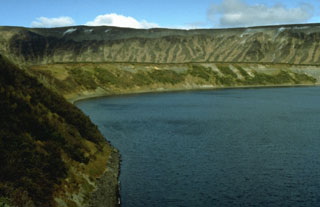 The Lake Dalny maar formed about 7,600-7,700 years ago in the the northern area of Uzon caldera. Tephra deposits from this eruption are found within 5 km from the lake. The 1-km-wide maar is surrounded by a 60-m-high tephra ring that forms the flat slope on the far side of the lake. The northern wall of Uzon caldera rises behind it.
The Lake Dalny maar formed about 7,600-7,700 years ago in the the northern area of Uzon caldera. Tephra deposits from this eruption are found within 5 km from the lake. The 1-km-wide maar is surrounded by a 60-m-high tephra ring that forms the flat slope on the far side of the lake. The northern wall of Uzon caldera rises behind it. The Uzon and Geyzernaya calderas, containing Kamchatka's largest geothermal area, form a 7 x 18 km depression that formed during the mid-Pleistocene. Post-caldera activity was largely Pleistocene in age, although the Lake Dal'ny maar formed during the early Holocene. This view looks from the SW across the flat caldera floor, which contains numerous lakes, streams, and thermal areas. Sharp-peaked Kronotsky volcano and flat-topped Krasheninnikov volcano appear in the distance beyond the N caldera rim.
The Uzon and Geyzernaya calderas, containing Kamchatka's largest geothermal area, form a 7 x 18 km depression that formed during the mid-Pleistocene. Post-caldera activity was largely Pleistocene in age, although the Lake Dal'ny maar formed during the early Holocene. This view looks from the SW across the flat caldera floor, which contains numerous lakes, streams, and thermal areas. Sharp-peaked Kronotsky volcano and flat-topped Krasheninnikov volcano appear in the distance beyond the N caldera rim.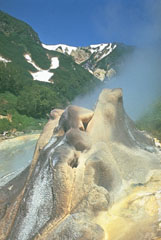 The Dvoinoi (Sugar) geyser is one of nearly 30 found in the "Valley of Geysers," a major geothermal area along a 4-km-long valley near the eastern margin of the Geysernaya caldera at Kamchatka's Uzon volcano. High heat flux near the eastern ring faults of the caldera produces active geysers, boiling hot springs, and mud pools.
The Dvoinoi (Sugar) geyser is one of nearly 30 found in the "Valley of Geysers," a major geothermal area along a 4-km-long valley near the eastern margin of the Geysernaya caldera at Kamchatka's Uzon volcano. High heat flux near the eastern ring faults of the caldera produces active geysers, boiling hot springs, and mud pools. The Vostochny Thermal Field in the northern part of Uzon caldera contains a large number of thermal lakes and springs. A narrow area 200-300 m x 5 km contains fumaroles, boiling hot springs with colonies of blue-green algae, and mud pots. The northern caldera wall forms the ridge in the background.
The Vostochny Thermal Field in the northern part of Uzon caldera contains a large number of thermal lakes and springs. A narrow area 200-300 m x 5 km contains fumaroles, boiling hot springs with colonies of blue-green algae, and mud pots. The northern caldera wall forms the ridge in the background.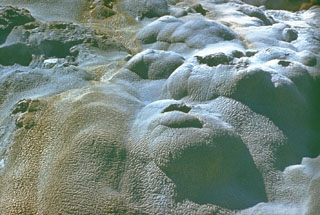 Extensive deposits of siliceous sinter have formed in the Valley of Geysers, a major geothermal area at the eastern end of the Uzon-Geysernaya caldera complex that contains 30 geysers.
Extensive deposits of siliceous sinter have formed in the Valley of Geysers, a major geothermal area at the eastern end of the Uzon-Geysernaya caldera complex that contains 30 geysers.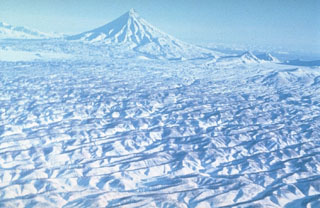 Kronotsky, seen here from the SW, towers above extensively eroded pyroclastic flow deposits. These voluminous deposits were produced by Pleistocene explosive eruptions that resulted in formation of the Uzon and Krasheninnikov calderas. The initial caldera-forming eruption at Uzon dates back to the mid-Pleistocene. A younger caldera formed about 39,000 years ago and was followed shortly by formation of the Krasheninnikov caldera.
Kronotsky, seen here from the SW, towers above extensively eroded pyroclastic flow deposits. These voluminous deposits were produced by Pleistocene explosive eruptions that resulted in formation of the Uzon and Krasheninnikov calderas. The initial caldera-forming eruption at Uzon dates back to the mid-Pleistocene. A younger caldera formed about 39,000 years ago and was followed shortly by formation of the Krasheninnikov caldera.Maps are not currently available due to technical issues.
There are no samples for Uzon in the Smithsonian's NMNH Department of Mineral Sciences Rock and Ore collection.
| Copernicus Browser | The Copernicus Browser replaced the Sentinel Hub Playground browser in 2023, to provide access to Earth observation archives from the Copernicus Data Space Ecosystem, the main distribution platform for data from the EU Copernicus missions. |
| MIROVA | Middle InfraRed Observation of Volcanic Activity (MIROVA) is a near real time volcanic hot-spot detection system based on the analysis of MODIS (Moderate Resolution Imaging Spectroradiometer) data. In particular, MIROVA uses the Middle InfraRed Radiation (MIR), measured over target volcanoes, in order to detect, locate and measure the heat radiation sourced from volcanic activity. |
| MODVOLC Thermal Alerts | Using infrared satellite Moderate Resolution Imaging Spectroradiometer (MODIS) data, scientists at the Hawai'i Institute of Geophysics and Planetology, University of Hawai'i, developed an automated system called MODVOLC to map thermal hot-spots in near real time. For each MODIS image, the algorithm automatically scans each 1 km pixel within it to check for high-temperature hot-spots. When one is found the date, time, location, and intensity are recorded. MODIS looks at every square km of the Earth every 48 hours, once during the day and once during the night, and the presence of two MODIS sensors in space allows at least four hot-spot observations every two days. Each day updated global maps are compiled to display the locations of all hot spots detected in the previous 24 hours. There is a drop-down list with volcano names which allow users to 'zoom-in' and examine the distribution of hot-spots at a variety of spatial scales. |
|
WOVOdat
Single Volcano View Temporal Evolution of Unrest Side by Side Volcanoes |
WOVOdat is a database of volcanic unrest; instrumentally and visually recorded changes in seismicity, ground deformation, gas emission, and other parameters from their normal baselines. It is sponsored by the World Organization of Volcano Observatories (WOVO) and presently hosted at the Earth Observatory of Singapore.
GVMID Data on Volcano Monitoring Infrastructure The Global Volcano Monitoring Infrastructure Database GVMID, is aimed at documenting and improving capabilities of volcano monitoring from the ground and space. GVMID should provide a snapshot and baseline view of the techniques and instrumentation that are in place at various volcanoes, which can be use by volcano observatories as reference to setup new monitoring system or improving networks at a specific volcano. These data will allow identification of what monitoring gaps exist, which can be then targeted by remote sensing infrastructure and future instrument deployments. |
| Volcanic Hazard Maps | The IAVCEI Commission on Volcanic Hazards and Risk has a Volcanic Hazard Maps database designed to serve as a resource for hazard mappers (or other interested parties) to explore how common issues in hazard map development have been addressed at different volcanoes, in different countries, for different hazards, and for different intended audiences. In addition to the comprehensive, searchable Volcanic Hazard Maps Database, this website contains information about diversity of volcanic hazard maps, illustrated using examples from the database. This site is for educational purposes related to volcanic hazard maps. Hazard maps found on this website should not be used for emergency purposes. For the most recent, official hazard map for a particular volcano, please seek out the proper institutional authorities on the matter. |
| IRIS seismic stations/networks | Incorporated Research Institutions for Seismology (IRIS) Data Services map showing the location of seismic stations from all available networks (permanent or temporary) within a radius of 0.18° (about 20 km at mid-latitudes) from the given location of Uzon. Users can customize a variety of filters and options in the left panel. Note that if there are no stations are known the map will default to show the entire world with a "No data matched request" error notice. |
| UNAVCO GPS/GNSS stations | Geodetic Data Services map from UNAVCO showing the location of GPS/GNSS stations from all available networks (permanent or temporary) within a radius of 20 km from the given location of Uzon. Users can customize the data search based on station or network names, location, and time window. Requires Adobe Flash Player. |
| DECADE Data | The DECADE portal, still in the developmental stage, serves as an example of the proposed interoperability between The Smithsonian Institution's Global Volcanism Program, the Mapping Gas Emissions (MaGa) Database, and the EarthChem Geochemical Portal. The Deep Earth Carbon Degassing (DECADE) initiative seeks to use new and established technologies to determine accurate global fluxes of volcanic CO2 to the atmosphere, but installing CO2 monitoring networks on 20 of the world's 150 most actively degassing volcanoes. The group uses related laboratory-based studies (direct gas sampling and analysis, melt inclusions) to provide new data for direct degassing of deep earth carbon to the atmosphere. |
| Large Eruptions of Uzon | Information about large Quaternary eruptions (VEI >= 4) is cataloged in the Large Magnitude Explosive Volcanic Eruptions (LaMEVE) database of the Volcano Global Risk Identification and Analysis Project (VOGRIPA). |
| EarthChem | EarthChem develops and maintains databases, software, and services that support the preservation, discovery, access and analysis of geochemical data, and facilitate their integration with the broad array of other available earth science parameters. EarthChem is operated by a joint team of disciplinary scientists, data scientists, data managers and information technology developers who are part of the NSF-funded data facility Integrated Earth Data Applications (IEDA). IEDA is a collaborative effort of EarthChem and the Marine Geoscience Data System (MGDS). |